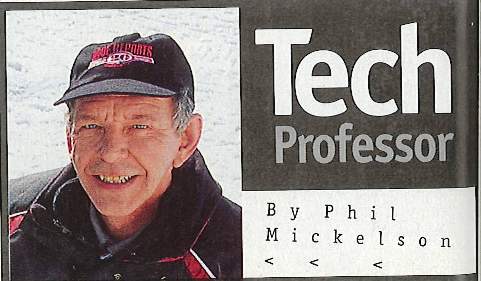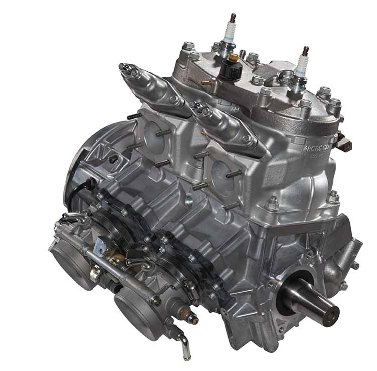Understanding Torque And Horsepower In A Snowmobile Engine
Fifteen years ago this month, the late, great Phil Mickelson penned this Tech Professor column for the August 1999 issue of Snow Goer magazine. It explains the difference between torque and horsepower, and the only ways that more performance can get gained out of an engine. Its lessons are still as valuable today as they were the day Phil wrote the column. — Editor
Force, work, torque, time and power; they’re all units you have to deal with to gain an understanding of how we rate engines against each other.
The output of an engine begins when a force is applied to the pistons. The force applied comes from the rapid expansion of gases created during combustion in the cylinder. The pressure in the cylinder varies throughout the power stroke, but to predict an engine’s output, engineers determine an average pressure on the piston during the power stroke. This average considers the compression ratio of the engine, the fuel used, the breathing or volumetric efficiency of the engine and a host of other factors defining an engine’s output.
The figure they come up with is called the brake mean effective pressure (BMEP). The BMEP is measured in pounds per square inch (PSI) and, when multiplied by the cross-sectional area of the bore, provides the force, in pounds, that is pushing on the piston.
The straight line displacement of the piston and the force behind it has to be converted into twisting energy, or torque. This is the job of the connecting rod and crankshaft. The connecting rod takes the force from the piston and applies it to the crankpin, which is one-half the stroke-length of the engine from the axis of rotation of the crankshaft. The angle of the connecting rod is constantly changing and its mechanical advantage over the crankpin is at its maximum only when the crankpin is at 90 degrees after top dead center (ATDC).
There are three things that affect torque: the general design of the engine; whether the piston pin is offset in the piston; and the connecting rod lengths. All have something to do with how efficiently the force from the piston is transferred to the crankshaft.
Because torque is a force producing an angular displacement of the crankshaft, you can think of torque as the “work” that an engine can do. The torque output of an engine is predicted by multiplying the total displacement of the engine by its BMEP. The unit of torque is the pound-foot. You can see that there are only two ways to increase the torque output of an engine: increase the displacement by boring or stroking the engine or increase the BMEP.
All the high-tech advances in two-stroke engine design today are focused on improving an engine’s BMEP. Variable-height exhaust ports, digital ignition systems, improved reed valve designs, new head and piston dome shapes and electronically-controlled intake systems all seek to optimize the BMEP somewhere in the operating range of the engine.
OK, we’ve done everything we can to maximize the torque output of the engine, so what’s happening to the power? Power is simply the rate at which the engine does its work. The time element used when studying power in rotating shafts is most commonly recorded in revolutions per minute (RPM).
Horsepower was defined by Scottish inventor James Watt (1736-1819). From studying horses, he found that the average horse could work at a rate of 33,000 pound-feet per minute, or 550 pound-feet per second. We use the same units today to rate our engines, however, you may see power ratings given in watts (1 HP=746 watts).
 With an engine mounted on a dynamometer, the torque output can be measured at any desired RPM. To discover the horsepower at any given RPM, simply multiply the torque recorded by the dyno by the RPM then divide the product by the dynamometer constant, 5252. Readings taken directly from the dynamometer are referred to as “observed” torque and horsepower. Corrections must be made for temperature and other atmospheric conditions to come up with the “corrected” horsepower and torque figures.
With an engine mounted on a dynamometer, the torque output can be measured at any desired RPM. To discover the horsepower at any given RPM, simply multiply the torque recorded by the dyno by the RPM then divide the product by the dynamometer constant, 5252. Readings taken directly from the dynamometer are referred to as “observed” torque and horsepower. Corrections must be made for temperature and other atmospheric conditions to come up with the “corrected” horsepower and torque figures.
You can see that if one engine produces less torque than another at a particular RPM, the engine may be able to produce the same peak horsepower but at a higher RPM. Let’s say we have one engine producing 70 pound-feet of torque at 8000 RPM. That engine would be producing 106 HP. Another engine may be tuned differently and produces its peak horsepower at a little more than 11,000 RPM while making 60 pound-feet of torque.
The power band of an engine is the range of RPM where the engine produces usable power. This range of RPM usually is considered to be from engagement RPM to about 100 RPM beyond the point where peak power is produced.
When working with engines of equal displacement, increases in power must come from increased compression ratios, higher port timing, more ignition advance, more efficient tuned exhaust systems, etc. Some of these modifications, such as higher or longer duration port openings, will increase the operating speed of the engine in order to take advantage of the improved breathing made possible by the longer duration exhaust and transfer port timing. The engine will actually make less torque most of the way through its operating range but the engine will make more power when it is “on the pipe.” This will necessitate increasing the engagement RPM of the clutch and slowing the upshift to allow the engine to turn enough RPM to stay on the new power peak.
The lower the RPM you can operate at, the better, provided you are attaining the peak power you want. Clutch engagement will be smoother, drive belt life will be longer, sound levels are easier to live with and, because transmission efficiency falls off with increased drive belt speed, the overall efficiency of the drive line will be improved. Wider power bands are much easier to clutch than peaky, narrow power bands. The system will also be much less sensitive to belt wear and changes in atmospheric conditions that can shift the power peak from day to day.
The exhaust port height modifiers on many of today’s engines are a means of allowing the use of longer duration exhaust ports without sacrificing torque at lower RPM. When the engine is below peak power, the port height drops, allowing more torque to be developed at lower speeds.
Digital ignition systems allow engineers to map the ignition point based on engine speed and, in some cases, engine speed and throttle position. Ignition timing can be advanced to maintain a higher BMEP at lower engine speeds; then retarded at speeds where the BMEP is coming up based on port timing and tuned exhaust effects.
A “torque” engine today can be defined as an engine that will not vary by more than 2 HP within 250 RPM to each side of the power peak.
